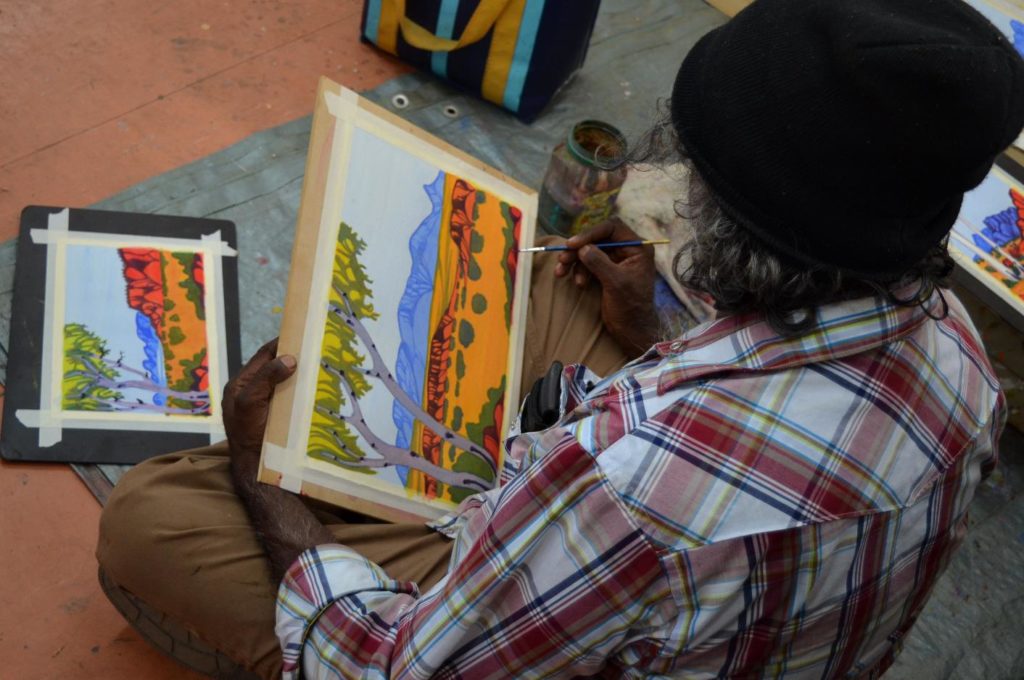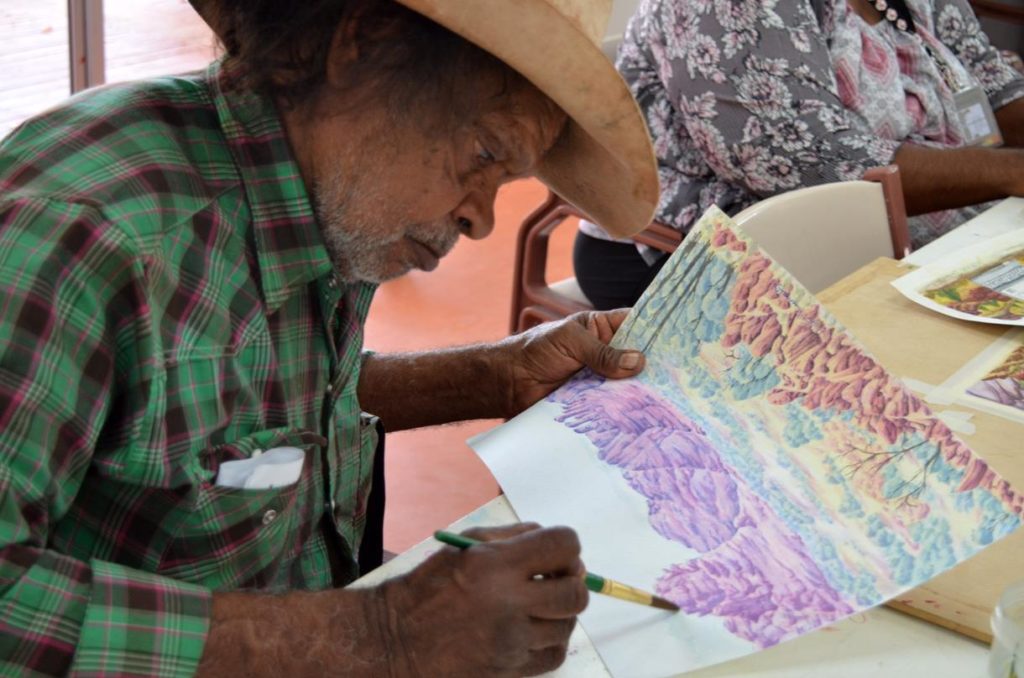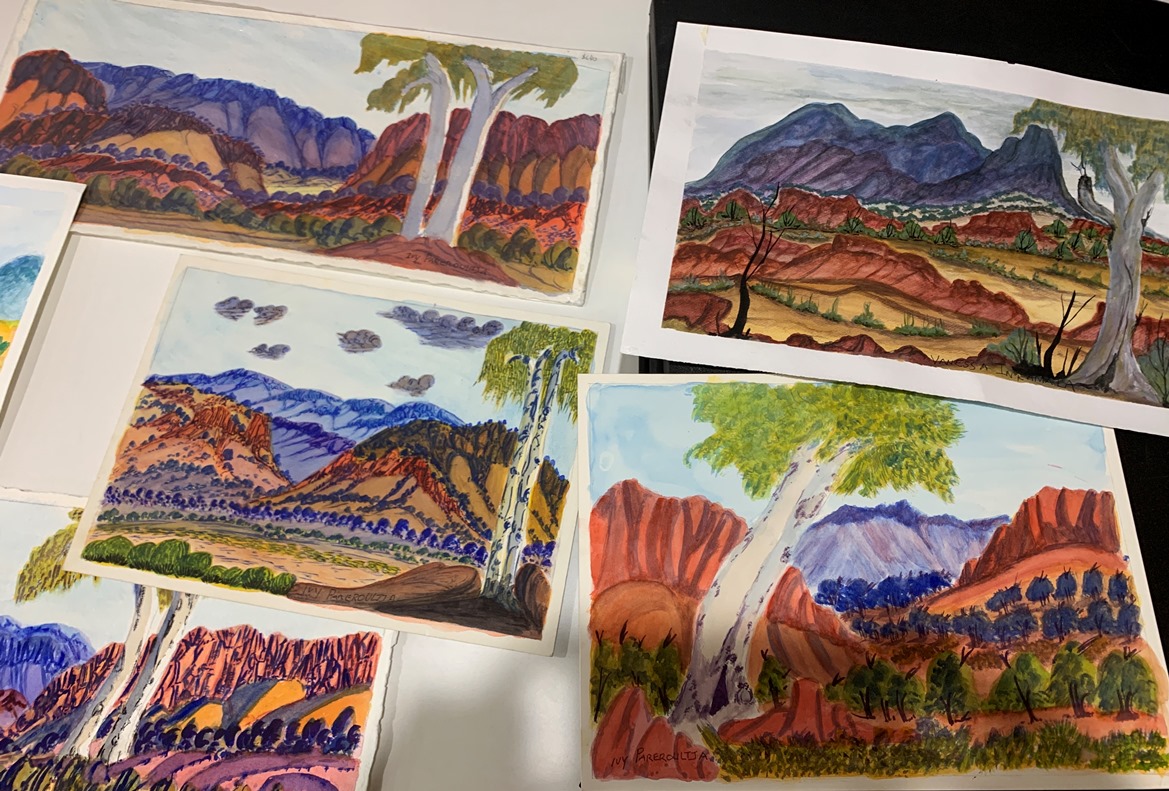Families & Watercolour Painting Traditions From Central Australia
Marisa Maher is part of the team at Many Hands Art Centre. She is an Indigenous Aranda woman. The Arrernte Aboriginal people live on their traditional lands at Alice Springs and the surrounding areas of Central Australia. Marisa is part of the extended clan group who gather together at the art centre to continue the watercolour landscape painting tradition that originally came out of Hermannsburg and was made famous by Albert Namatjira. In this interview Marisa talks about the work of the art centre and her role curating exhibitions for the group.
How long have you worked at the art centre and how did you get involved?
I've been here for about seven years. Before we moved to our art studio, we were based up at Desert Park in Alice Springs. From there we decided to come back to the studio where it was easier for the artists to come to sit and paint every day. We could move forward when we came out this way. It was a good move for the artists to come back here.

Where did your family come from?
Hermannsburg. My mother and grandmother were born at Hermannsburg. So that gives me that connection with all the artists because back then our families grew up close together, including all the first-generation artists.
What have been the highlights of your time working there?
I've enjoyed getting more confident with curating the exhibitions. I like getting the works together and hanging them. I enjoy doing all the exhibition work that is involved in curation.
It seems that the art centre offers new materials and techniques for the artists to try. Can you tell me a little bit about some of the projects?
There's a lot of different activities that are happening throughout the year around Alice Springs. I like working with the artists and coming together to develop concepts for them to paint and share their stories, depending on whether they use watercolour or acrylic. We sometimes explore the different things that are happening with the land. We might look at the country and how it's changed. A lot of the artists like to talk about how it was before and what it looks like now. There is a lot of mining happening. They like to speak about those changes and how it's been over the years.

What's the main advantages of these new projects, do you think?
Rather than just the traditional watercolour, how it used to be from Albert and those first-generation artists, the artists have changed over the years in the type of colours they use and the amount of detail. They like to put more detail into their work. Rather than just having the land they might include housing or people or try out different techniques that might change the feel of the painting.
The history of the artists goes back to the 1930s and it's one of the longest art traditions of any group. How do the artists feel about that tradition?
I think they're proud because they continue with what their fathers, uncles and grandfathers did in those early generations. They love to keep it going. They enjoy sharing the stories and knowledge of what they were told about the country and how they were taught to paint. They bring that through for everyone to share their knowledge. For the families this means they can be proud of where they are, who they are and where their families have come from. This is especially true of their fathers and grandfathers, those are first-generation painters. They just continue on.
Do the direct descendants of Albert Namatjira have a seniority among the artists? Or is it just based on developing their own skills?
I think it's just developing their own skills. They tend to teach each other as well. They give each other tips and enjoy teaching each other and showing each other how best to do the painting. They enjoy just working together in the arts centre. Just sharing what they know and sharing their knowledge with everybody else as well.

How many people regularly use the art centre or come through there?
Between six to eight will come in quite regularly, which is a good number for us because some of our artists are based out of Hermannsburg. We try to get out there to them to reconnect with them and to make sure they have enough materials. It is about just looking after each other.
The international market a big part of the sales for the artists?
We do get quite a number of international sales and interested visitors as well. People travelling from overseas will come to visit us. They come through the studio and speak to the artists and then they'll purchase an item like a painting. This is really good.
What are the highlights of the year for you and the artists?
Last year there was the major exhibition that I curated with the Flinders University Museum of Art and the Art Gallery of South Australia during the Tarnanthi Art Fair. That was one of the highlights. It gave the artists an opportunity to showcase their current paintings with the first-generation painters. To have them all hung in the one space, I think it made the artists proud to be able to share that space with the first generation of artists from their families.
What do you think would be the best thing that could happen to help the artists at Many Hands?
I want to see it continuing on, doing more work and trying to get involved with as many institutions inter-state to promote our arts and our artists. I want to see the artists doing different concept stories of their work, because a lot of people like to see works that have a story or an interest that is different to the traditional style.
If people haven't been to your art centre can you describe what it's like?
We've had quite a number of renovations done in the last year. It's actually made it more easy to access and the artists feel more comfortable being here. Now when you walk in, the artists are doing their work, they sit more peacefully, they can talk to each other, tell stories, they can sit outside if they like. It's just a really good environment to be around and be here with all the artists while they're painting because they like to tell stories, they like to share everything with everybody.

What sort of thing do the artists say about the arts centre and working there?
I think the artists enjoy being here because sometimes when they're at home, they're bored, they have nothing to do. A lot of their close family aren't around. It's very important for them to come in and to be around other people and the extended family. We're all connected, we're all family from one community. When they come here they have people who they can talk to and feel comfortable being around. Many don't get to see a lot of their immediate families because they're all out bush.
When do you see the artists happy and excited?
I think when they're doing their work and they see it finished and they're sharing it with each other. They get excited because they encourage each other, "Oh, it's really good" or "you've done a great job!" They feel proud of themselves. I think they like coming here because they get to do their work. They can work slowly - they're not in a rush. For them it's like, "We come here just to relax and do our painting."
Do you see much interest from young people in making art? How do you encourage that?
That's something that we are working on. We are keen to get more and more younger people in. Recently, we've worked with the various schools up at Hermannsburg with the younger kids doing projects with them. A lot of them have a connection to all the families and artists here. I think it's just slowly getting to the communities to work with the younger children and to develop them, so as they get older they can come here and do their paintings.
What do you think makes for a good healthy arts centre?
I think it's just about being positive, being happy, sharing our stories, supporting each other. I think that's the main thing. For us to support each other and be there for each other - that's what makes a good art centre.
What are you most proud of about Many Hands? What's the thing that you think you do really well?
I think we are good at communicating with the artists and being there for them. Letting them know what projects we have coming up. That way they can work on more paintings and get involved with those projects. For exhibitions, they like to come up with different concepts and stories of what we can do in a exhibition. We are good at getting them involved in the stories.
In the time that you've been with the art centre, what experiences have meant a lot to you?
I think it's when we do our bush trips out to Hermannsburg and we're painting on country. I find getting out there with them is relaxing. For us it is to get out of the art centre and get into that environment where they grew up, where they are from. I think that's one of the best things to do, just to get them out and about and back to country to paint. It means great deal to me.
View the Exhibition or read the Exhibition Walk Through
View our Hermannsberg Watercolour collection
